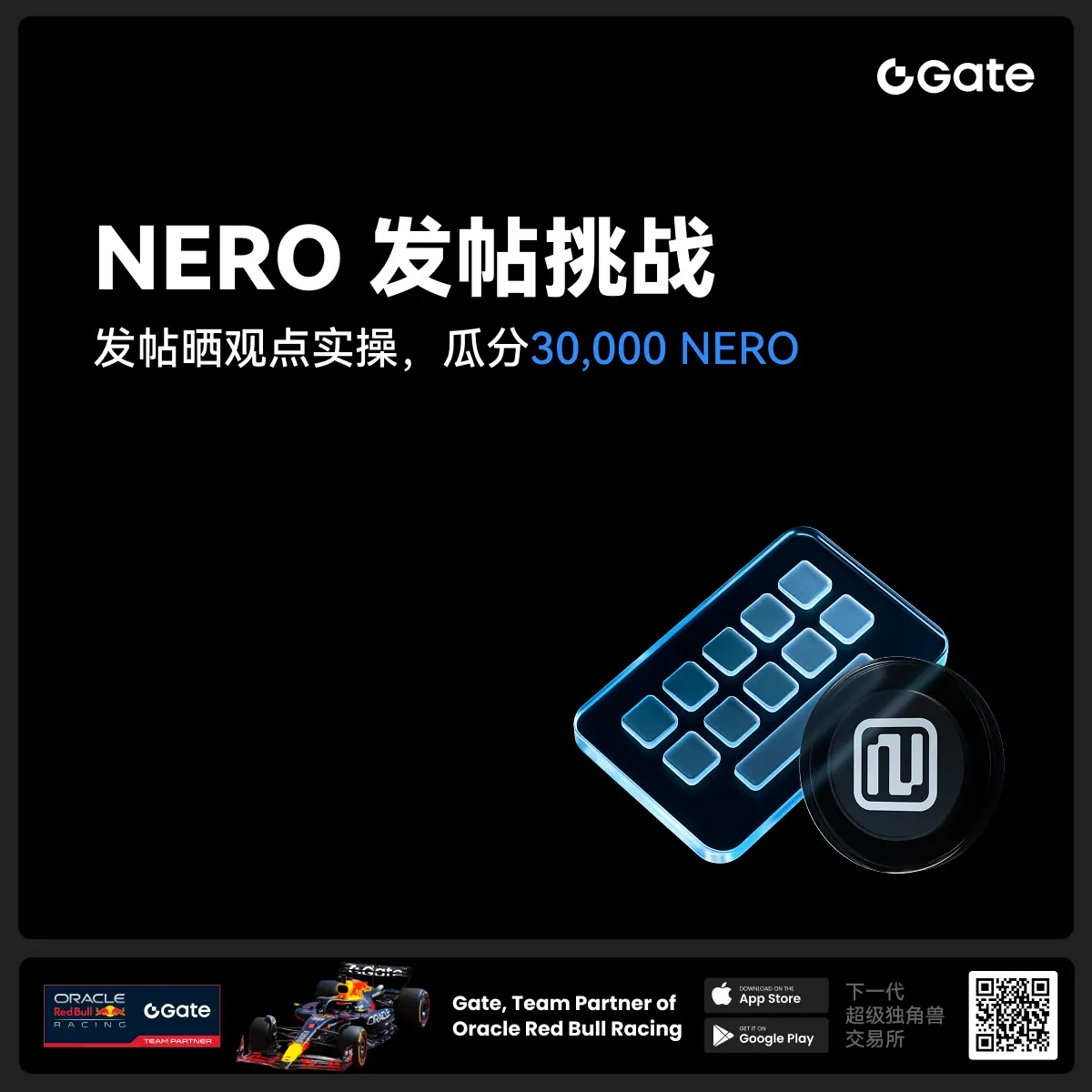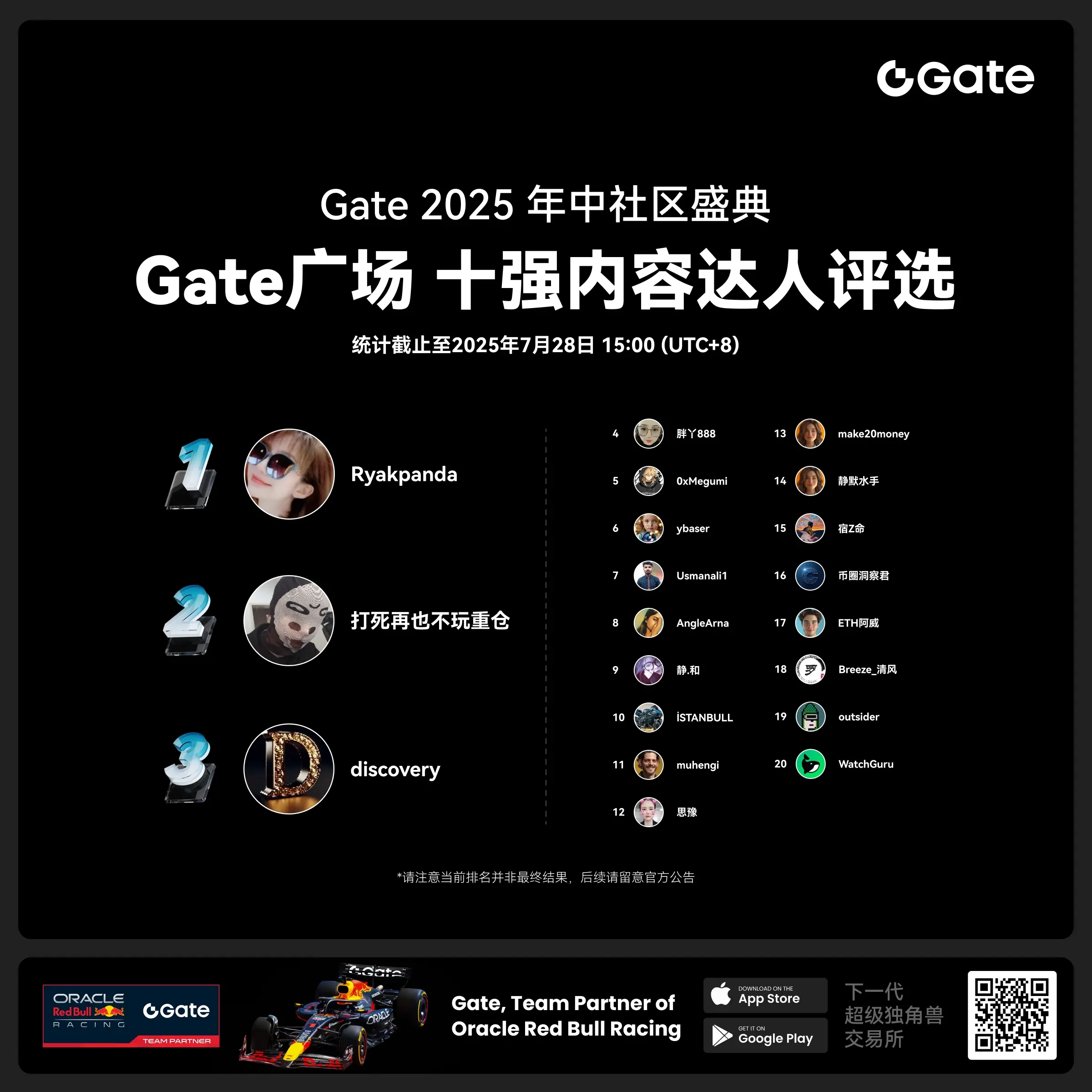- 話題1/3
21k 熱度
2k 熱度
7k 熱度
6k 熱度
16k 熱度
- 置頂
- 🎉 攢成長值,抽華爲Mate三折疊!廣場第 1️⃣ 2️⃣ 期夏季成長值抽獎大狂歡開啓!
總獎池超 $10,000+,華爲Mate三折疊手機、F1紅牛賽車模型、Gate限量週邊、熱門代幣等你來抽!
立即抽獎 👉 https://www.gate.com/activities/pointprize?now_period=12
如何快速賺成長值?
1️⃣ 進入【廣場】,點擊頭像旁標識進入【社區中心】
2️⃣ 完成發帖、評論、點讚、發言等日常任務,成長值拿不停
100%有獎,抽到賺到,大獎等你抱走,趕緊試試手氣!
截止於 8月9日 24:00 (UTC+8)
詳情: https://www.gate.com/announcements/article/46384
#成长值抽奖12期开启#
- 📢 Gate廣場 #NERO发帖挑战# 秀觀點贏大獎活動火熱開啓!
Gate NERO生態周來襲!發帖秀出NERO項目洞察和活動實用攻略,瓜分30,000NERO!
💰️ 15位優質發帖用戶 * 2,000枚NERO每人
如何參與:
1️⃣ 調研NERO項目
對NERO的基本面、社區治理、發展目標、代幣經濟模型等方面進行研究,分享你對項目的深度研究。
2️⃣ 參與並分享真實體驗
參與NERO生態周相關活動,並曬出你的參與截圖、收益圖或實用教程。可以是收益展示、簡明易懂的新手攻略、小竅門,也可以是行情點位分析,內容詳實優先。
3️⃣ 鼓勵帶新互動
如果你的帖子吸引到他人參與活動,或者有好友評論“已參與/已交易”,將大幅提升你的獲獎概率!
NERO熱門活動(帖文需附以下活動連結):
NERO Chain (NERO) 生態周:Gate 已上線 NERO 現貨交易,爲回饋平台用戶,HODLer Airdrop、Launchpool、CandyDrop、餘幣寶已上線 NERO,邀您體驗。參與攻略見公告:https://www.gate.com/announcements/article/46284
高質量帖子Tips:
教程越詳細、圖片越直觀、互動量越高,獲獎幾率越大!
市場見解獨到、真實參與經歷、有帶新互動者,評選將優先考慮。
帖子需原創,字數不少於250字,且需獲得至少3條有效互動
- 🎉 親愛的廣場小夥伴們,福利不停,精彩不斷!目前廣場上這些熱門發帖贏獎活動火熱進行中,發帖越多,獎勵越多,快來GET你的專屬好禮吧!🚀
1️⃣ #GateLaunchpad上线IKA# |IKA認購體驗
在Gate廣場帶話題曬出你的IKA Launchpad認購體驗,4位幸運分享者講瓜分$200分享獎池!
詳情 👉️ https://www.gate.com/post/status/12566958
2️⃣ #ETH冲击4800# |行情分析預測
大膽發帖預測ETH走勢,展示你的市場洞察力!10位幸運用戶將平分0.1 ETH 獎勵!
詳情 👉️ https://www.gate.com/post/status/12322403
3️⃣ #创作者活动第二期# |ZKWASM話題
在廣場或推特發布與 ZKWASM 或其交易活動相關的原創內容,瓜分4,000枚ZKWASM!
詳情 👉️ https://www.gate.com/post/status/12525794
4️⃣ #Gate广场征文活动第二期# |ERA話題
談談你對ERA的觀點/體驗,參與並推廣活動,700 ERA大獎等你贏!
詳情 👉️ https://www.gate.com/post/status/12361653
5️⃣ #MBG任务挑战# |MBG話題
分享你對MBG的洞察,積極參與和推廣MBG活動,20位小 - 親愛的廣場用戶們, #Gate 2025年中社区盛典# 投票中!🔥
🙌 廣場內容達人TOP40榜單新鮮出爐!速速圍觀榜單,爲你喜愛的達人瘋狂打call吧:
www.gate.com/activities/community-vote
每天完成【廣場】互動任務可獲得助力值,每投出30助力值即可參與抽獎一次!
iPhone 16 Pro Max 512G、金牛雕塑、潮流運動套裝、合約體驗券、熱門幣種等你抽!
助力越多,中獎機率越大,下一個抱走iPhone 16的錦鯉就是你!🧧
別猶豫,帶上你的“歐氣”,爲達人衝榜贏大獎!
https://www.gate.com/announcements/article/45974
- 🎉 Gate 廣場 IKA Launchpad 發帖活動來襲!🎉
Gate Launchpad 認購 IKA 最後24小時!曬出你的認購體驗,和大家一起分享,每個人都有機會瓜分 $200 獎池!
🎁 4位幸運分享者*$50合約體驗券每人!
🧐 如何參與:
1.在廣場發帖,帶上 #GateLaunchpad上线IKA# 標籤
2.曬出你的認購截圖 或 分享你的獨特認購小竅門/心得或趣事
3.保證帖子大於50字,內容有趣有料,原創,集齊至少3個互動(點讚/評論/轉發)
IKA認購連結:https://www.gate.com/launchpad/2336?downgarde=true
活動時間:7月28日 12:00 - 7月30日 24:00 (UTC+8)
趕快加入,分享你的精彩時刻,你就是下一個幸運兒!
DePIN: 萬億級市場的Web3基礎設施新範式
DePIN: 去中心化物理基礎設施網路的創新與前景
去中心化物理基礎設施網路(DePIN)正在revolutionizing傳統物理基礎設施部署和維護的方式。這種創新模式由全球各地的個人和企業以分布式方式構建,任何人都可以使用。作爲回報,基礎設施節點的貢獻者能獲得經濟補償和代幣激勵。通過結合加密技術、互聯網、物聯網和區塊鏈,DePIN實現了更高效、去中心化和公平的基礎設施部署模式。
DePIN對真正意義上的Web3至關重要。盡管基於Layer1和Layer2已經發展出了DeFi、遊戲、NFT、社交和RWA等應用場景,但這些Web3應用仍然依賴於中心化的雲服務和數據中心等互聯網基礎設施。行業內已經發生過因大型雲平台宕機導致Web3項目數據丟失的事件,也存在因監管制裁導致中心化服務商無法爲某些Web3項目提供服務的情況。
相比傳統的中心化物理基礎設施網路,DePIN具有以下優勢:
DePIN產業邏輯簡單,主要包括三個關鍵角色:設備提供者、DePIN協議和網路使用方。要維持這種循環的穩定發展,需要確保代幣價值相對穩定,並對DePIN協議價值有較完善的價值捕獲。
DePIN項目大致可分爲去中心化存儲、計算、CDN、VPN、WiFi和5G網路等類別。大多數DePIN具有三個基本組件:物理基礎設施、鏈下計算基礎設施以及區塊鏈和代幣。
目前,已經出現了一批DePIN項目案例:
去中心化存儲網路:全球最大的分布式存儲網路,擁有超過3800個存儲提供者,貢獻了超過17M TB的存儲容量。
去中心化GPU渲染平台:撮合執行渲染作業的用戶與具有空閒GPU的用戶,用於3D渲染和AI行業的分布式GPU計算。
去中心化無線網路協議:激勵世界各地的人們共同構建無線網路,包括IoT和5G網路。
去中心化直播視頻廣播平台:通過加密經濟協議激勵節點在實時視頻編碼和分發服務中貢獻GPU和帶寬。
去中心化視頻流媒體網路:通過代幣激勵個人用戶共享富餘算力和帶寬資源,作爲視頻流的緩存或中繼節點。
從行業發展情況來看,DePIN是一個從早期階段就開始逐步發展的賽道,近兩年有較多拓展。據研究,DePIN行業的總潛在市場規模大約爲2.2萬億美元,到2028年可能達到約3.5萬億美元。而目前所有去中心化物理基礎設施項目的FDV僅爲50億美元,顯示出巨大的增長潛力。